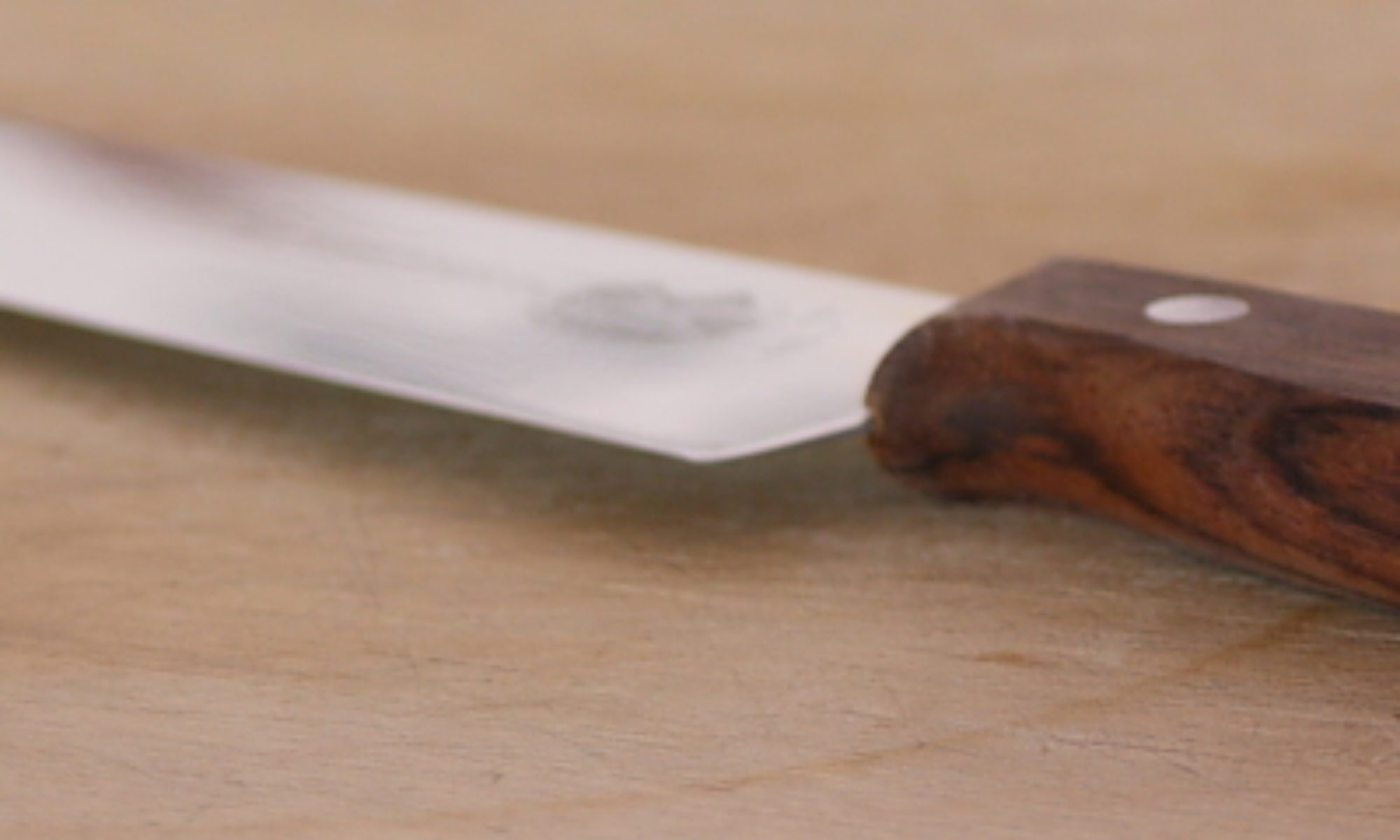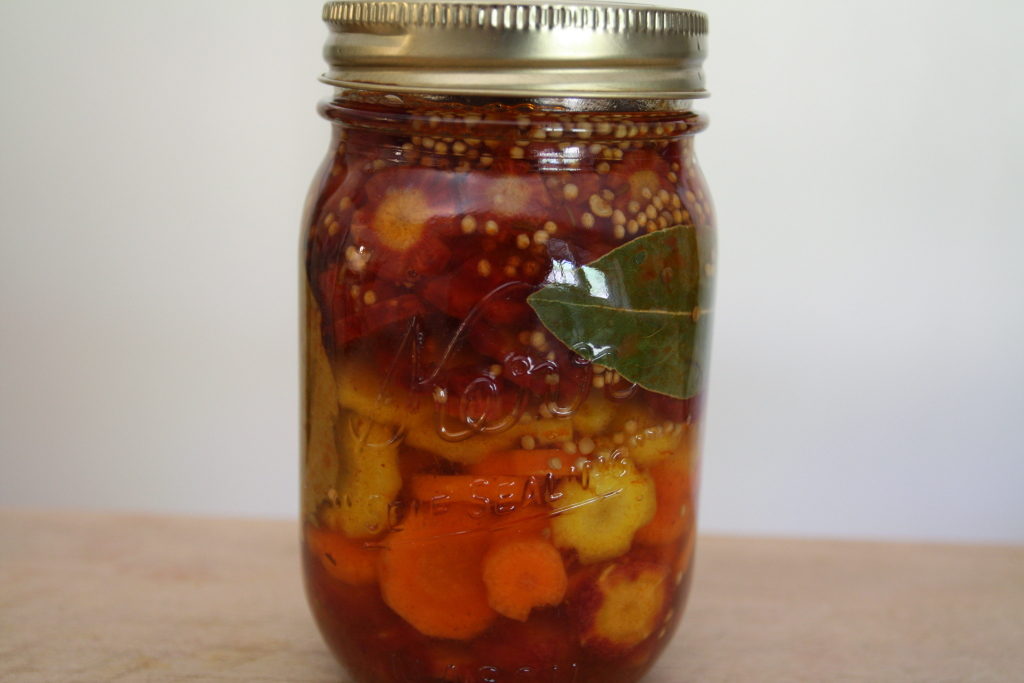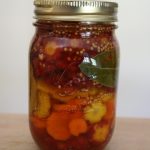
We’d guess that most people don’t make pickles very much anymore, which is a shame, because they’re often so easy. Now, we’re not talking the pickling that we remember from years ago: the packing of dozens of jars, the making of quarts of brine, the canning and sealing of Mason jars. We’re talking about small-batch pickles, of which you can make just a pint or so, and keep in the refrigerator for a snack. These are easy, and, with just a pint, it’s not that bad if you don’t like them. A case in point is these carrot pickles: we made exactly one pint, mainly because, with some of the ingredients required, we weren’t sure how they’d turn out.
The main ingredient we were concerned about was the Harissa. Now, we make Harissa, and, if we want to spice up a bowl of beans, a tiny amount of Harissa will do the trick. It is very spicy, so we weren’t sure if we’d want it in a pickle. Especially the amount that the original recipe called for (nearly 4 teaspoons, which we think would rip the taste buds off your tongue), so we cut back on the Harissa. Other than that change, we made these pickles according to the recipe in Honey & Co.: The Cookbook, by Itamar Srulovich and Sarit Packer.
Moroccan Carrot Pickle
Ingredients
- 4-5 large carrots peeled
- 150 g white wine vinegar (2/3 cup)
- 100 g water (Scant 1/2 cup)
- 60 g sugar (1/4 cup + 2 tsp)
- 1/2 tsp kosher salt
- 2 tsp yellow mustard seeds
- 2 bay leaves
- 4 whole cloves
- 1 tsp harissa
Instructions
- Score the carrots lengthwise five times using the tip of a sharp knife, a vegetable peeler, or a channeling knife.
- Slice into disks about 1/8 inch thick and place in pint jar. Slice enough carrots to fill a pint jar nearly to the neck.
- In a small saucepan, combine vinegar, water, sugar, salt, mustard seeds, bay leaves, and cloves. Place over high heat, stir to dissolve sugar and salt, and bring to a boil.
- Remove from heat and stir in harissa. Pour over carrots and cover jar.
- Place in refrigerator for at least 24 hours before serving.
Ingredient discussion:
We think you could use plain white vinegar or cider vinegar without a problem. After all, we do so for other pickles. For the mustard seed and bay leaves, we head on down to Penzey’s spices, where we can buy a large quantity at reasonable prices (we also make our own mustard, so we need a lot of mustard seeds). The elephant in the list is Harissa; you can read our post on how to make it, or you’ll need to start searching ethnic stores (which is a lot of fun) for this North African condiment.
Procedure in detail:
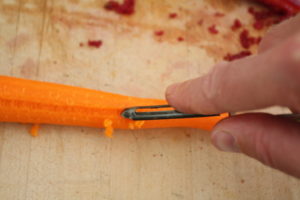
Channel carrots. This is optional, and only serves to make your carrot slices look like little flowers. We did it; it was a bit of trouble, but not too bad. We tried using the tip of vegetable peeler, and, while it worked, it was slightly troublesome. Using a knife to cut channels was somewhat easier. If you’re willing, carve five channels lengthwise into each carrot, using whatever tool works for you.
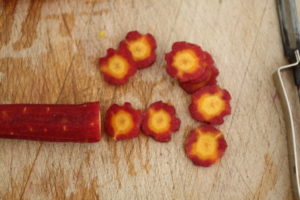
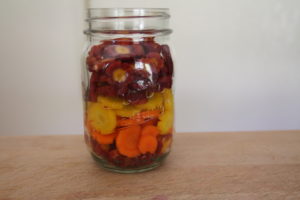
Slice and pack. Slice the carrots into disks about 1/8-inch thick. See, they look like little flowers, so we think it was worth the extra effort. As you’re slicing, place the disks in a pint jar, and use enough carrot slices to fill a pint jar nearly up to the neck. We found 4 carrots were just right, and we only had to eat a few bits of leftover carrot.
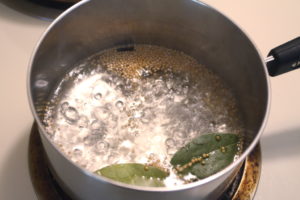
Make brine. In a small saucepan, combine the remaining ingredients, except the harissa. Why not the harissa? Well, it’s very spicy, so spicy it may make your eyes water as it comes to a boil with the brine, so don’t do it. Place the mixture over high heat, and, stirring to dissolve the sugar and salt, bring to a boil. Remove from heat.
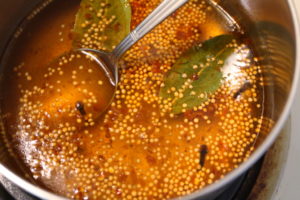
Stir in harissa. Add the harissa and stir in completely, turning the brine a nice red color. Be careful, and wash your hands thoroughly after dealing with the harissa.
Cover carrots. We pulled out the bay leaves and slid them down the side of the jar between the carrots and the glass, and we suggest you do the same. It’ll keep them out of the way while you pour, helping to prevent splashing, and they’ll stay submerged, adding flavor as the carrots pickle. Pour the bring over the carrots — you might have a little excess, but make sure the carrots are covered — and place the lid on the jar.
Refrigerate. It’ll take a while for the carrots to absorb the flavors, so place the jar in the refrigerator before trying the carrots. The pickled carrots should stay good for at least a couple of weeks.
Easy, peasy. See, we told you small-batch pickles are easy. Basically, pack and cover with hot brine, then refrigerate for a while. Now, we can’t tell you how these tasted, but we can say that they sure smelled spicy. Very spicy. But, that’s the nature of harissa. We’ll be updating this post in a week or so to give Moroccan Carrot Pickles a rating; until then, try making your own batch.
